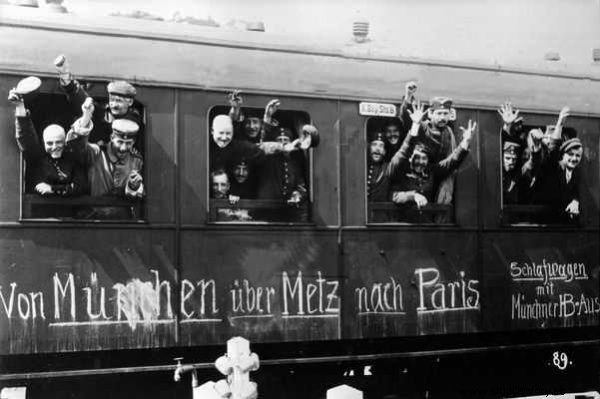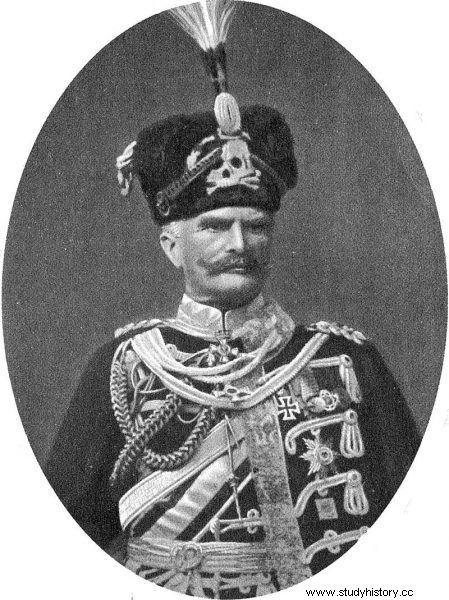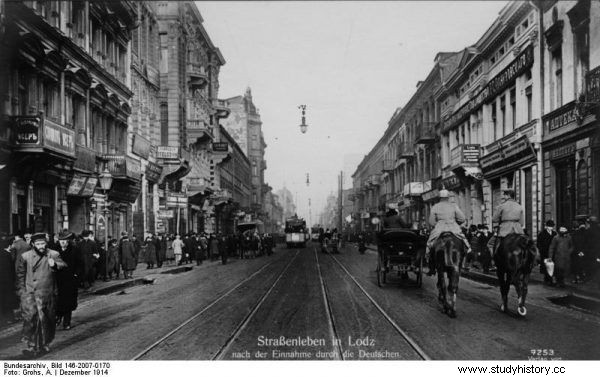Europe and the world have been preparing for this war for a long time. They were gearing up, although there was a common feeling that it was unlikely. The bloody experiences of the nineteenth and early twentieth centuries seemed to be a sufficient lesson for the next generations. It was believed that mankind had entered a peaceful era where the mutual economic and political dependence of states on each other prevented any aggressive action.
As it turned out, these futile hopes vanished like smoke from Gavril Princip's revolver. The shooting of the Austrian heir to the throne, Franz Ferdinand in Sarajevo, turned out to be a spark for a powder keg that Europe was in fact - within a month the continent was under arms.
Initially, it was a colorful war. In 1914, French soldiers fought in red trousers and kepi, so easy to spot by the enemy. The Germans fought in traditional, shiny pickel hats. Nobody thought about masking, and patriotic songs were heard over the battlefields.

Alfred von Schlieffen
It was a war in the spirit of the nineteenth century, but technologically it was already entering the era of aviation, long-range artillery, combat gases and submarines. In October, at Amiens, a charge of 200 French cavalrymen was swept away by machine gun fire - the bane of this war. In November, several thousand young German volunteers were fired at Langemarck with rifle fire, creating the legend of the slaughter of the innocents. There were more and more such bloody places, and not only in the Western theater of hostilities.
Lightning war?
In the first weeks of the war, the Germans did not attach much importance to the fighting on the Eastern Front. The majority of German forces were directed under the so-called Schlieffen's plan to the West to seize Paris as quickly as possible and force France to surrender. However, the German strategy of lightning warfare was never implemented against the Franco-British resistance and counterattack over the Marne. Simultaneously with the bloody fighting at the gates of Paris, at the desperate calls of the French side on August 4, the Russian army crossed the border of East Prussia. Despite the incomplete mobilization, the forces of generals Rennenkampf and Samsonov moved towards the Germans from two directions.
After the initial successes of the Russian side in the battles of Gołdapia and Gąbin, fueled more by enthusiasm than by skills, the tsarist war machine seemed to jam. The Germans, having rejected the original plan to withdraw to the Vistula line, decided to put up a strong resistance. At the risk of weakening the forces on the Western Front, they swiftly transferred two infantry corps and a cavalry division from France. Taking advantage of this strengthening and the lack of coordination of the actions of the Russian armies, the Germans fought against one of them with all their strength. In the Battle of Tannenberg (August 26–31), the Russian army was completely smashed, and its commander, General Samsonov, committed suicide. A week later, the Germans defeated another lonely tsarist army in the battle at the Masurian lakes. Its remnants retreated behind the Niemen, giving the field to the enemy.

German soldiers going to the front, the inscription on the wagon reads:From Munich through Metz to Paris
At the same time, in Galicia, the Russians managed to defeat the Austro-Hungarian army, approach Krakow, and then displace the German forces from the territory of the Kingdom of Poland. On the wave of these successes and at the strenuous requests of the French side, the Russian staff prepared an operation called "steam roller". Its aim was to attack Poznań, Berlin, Silesia and Vienna. It was hoped that this would be the final offensive in the East that would help end the war before Christmas. About 367,000 were prepared for the first attack. soldiers and about 1,300 guns.
Eastern Front
The plan had a good chance of success, if not for one detail. The German side learned from the staff dispatches taken over at the beginning of November, which the Russians often did not encrypt due to the lack of a sufficient number of trained personnel, found out which way the Russian roller was to pass. The Germans also realized that the Russian offensive had to be delayed due to supply difficulties. This only intensified the activities of the German staff, which, however, this time could not count on a quick reinforcement with reinforcements from the West. In this situation, it was necessary to use the available forces. By order of the newly appointed commander of the eastern front, General Hindenburg from the vicinity of Kalisz and Częstochowa, the newly created 9th army of General Mackensen was transferred to the Toruń-Inowrocław line. In the area of the expected attack by the Russian troops, the Germans concentrated approx. 250,000 people. soldiers from over 1,000 guns. Their activities were to support the Austro-Hungarian troops in the strength of 124,000 soldiers on the southern flank. people and 480 cannons.
Anticipating the Russians, on November 11, General Mackensen's troops launched an offensive that went down in history under the name of the "Łódź Operation". The plan of the German headquarters was to drive a wedge between the Russian armies and then encircle them. Thanks to their surprise, the Germans were systematically pushing the Russians towards Łódź. After the bloody fights, the Kaiser soldiers were handed over to Włocławek, Kutno and Łęczyca. The German artillery had no pardon for Aleksandrów, Konstantynów, Zgierz and Pabianice, which they turned to rubble.

August von Mackensen
The pace of the first blitzkrieg in the East was impressive - the Germans reached the outskirts of Łódź within 6 days. Barricades appeared in the streets of the city. Russian soldiers (especially officers) traveled to the defense line by trams, which on the way back acted as ambulance workers and often hearses. The city under fire and the wounded (about 40,000) soon ran out of medicine and food. The soldiers had to fight in the psychiatric hospital, whose patients scattered around the city, completing the image of the war horror. Soon the bleeding-out Russian regiments ran out of ammunition, and the specter of hunger and complete encirclement appeared in their eyes.
The Russians, however, did not lose their spirits, despite the fact that some units were already lacking in command. On the night of November 20-21, a strike group of Gen. Scheffer, whose task was to close the encirclement ring, encountered ... two Russian armored cars on the way to Pabianice - for the first time used on the Eastern Front. Their task was to cover the retreating troops. However, no one expected how much they would thwart German plans. An avalanche of lead from machine guns installed in Russian vehicles fell on the unsuspecting assault columns of Gen. Scheffer. Only after 10 minutes of the bloody slaughter, the Germans responded with fire. Although they eliminated armored cars, which, moreover, were lifted from the battlefield on their hands, the massacred regiments were no longer able to continue the attack. Worse, the Russians went into counterattack, with Russian reinforcements coming from the north. Now it was Scheffer's troops (three divisions commanded by General Litzmann) that faced the threat of encirclement.
Operation Łódź
The situation of the Germans became so serious that reinforcements began to be drawn from the Western Front. On November 23, in a bloody battle near Brzeziny, the Germans managed to break through to their own. The heroism of the Russian soldiers was useless. The daring cavalry charges, in which Semyon Budyonny, otherwise known to us, showed courage. By evening, the German artillery literally shot down Russian positions.
In one of the regiments, only 13 people were left alive, and the commander of the broken Russian division, General Hennings, suffered a nervous breakdown and screamed out of the battlefield. In turn, General Litzmann, for his maneuver to break out of the encirclement, was referred to as the "Lion from Brzeziny". However, the German units damaged by the battle were unable to undertake further offensive actions, and the Russians, licking their wounds, closed themselves in Łódź again. Both sides fell into position.

The Łódź operation turned out to be extremely bloody
However, with the arrival of German reinforcements from the West, General Mackensen decided to renew the attack on Russian positions. On November 30, the artillery cannonade began. The Russians, however, were too bled to undertake any further defense. Under a hail of German missiles, they left the city on December 5, and the next day the Germans entered Łódź.
The Łódź operation is considered to be undecided, although each side attributed the victory to itself. After all, the Germans eventually thwarted the Russian attack on the Reich, capturing Łódź at the same time. But the Russians, in turn, did not allow their forces to be completely encircled and quickly set up a new line of defense, 80 km east of the city. And what is very important - they forced the Germans to stop the offensive on the Western Front and go to trench warfare there.
After all, the 26-day Lodz battle brought terrible losses to the fighting parties. About 110,000 from the Russian ranks, and about 90,000 from the German ranks. soldiers (mostly Poles conscripted into the partitioning armies). This means that an average of 7,692 soldiers died in the fighting every day (definitely more than at the Somme or Verdun) and thus the steam roller near Łódź can be considered the bloodiest battle of the First World War.
